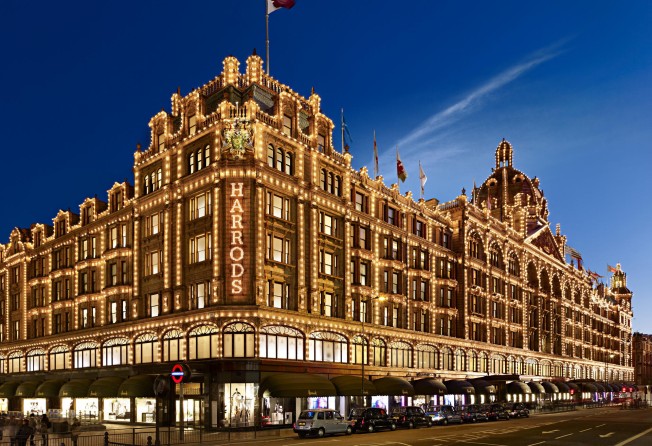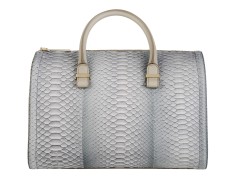Harrods targets Chinese consumers
British department stores cash in on China's growing wealth

London Fashion Week was in full swing last week, but in between the catwalk shows fashion watchers were sneaking off to the city's famous department stores for a little spot of retail therapy.
Chinese visitors were at the centre of this spending spree, cementing the country's place as the new shopping superpower. Today, it is not just fashion designers and luxury brands that have their sights set on Asia's potential - prestigious department stores are eyeing the region, too.
A recent report by the Economist Intelligence Unit indicated that by 2030 there would be 13 million households in China on an average income of US$150,000 per annum.
As well having deep pockets, mainland shoppers are discerning when it comes to spending money and they come well-prepared, knowing what they want to buy and how much it should cost.

If so, there is only one place in the world they will find them all under one roof; a place where they can also pick up special accessories from Vivienne Westwood, Proenza Schouler and evening wear from Ralph Lauren.
That place is Harrods.
Later this month the world-famous Knightsbridge store will open a new ready-to-wear luxury jewellery room followed in November by its extended fine jewellery room.
Harrods is reaping the rewards of active marketing in China through micro-blog service Weibo and Chinese translations of its publications, which are available for iPads. Furthermore, it brings in Chinese celebrities and fashion bloggers who post about their spending sprees at Harrods.
The store will also be hosting events for customers in Beijing and Shanghai later this year. Harrods has UnionPay terminals to accommodate the mainland's popular ATM card system, and Putonghua speakers are all around the store. Harrods will also have a promotion during the "golden week" holiday in October and the store's reward card is particularly popular.
According to Michael Ward, Harrods' managing director, the departments favoured by mainland tourists are watches, jewellery, fashion and accessories, with spending on beauty products, technology and wine and spirits increasing.
In the past five years, the number of Chinese shoppers at Harrods has grown by 68 per cent and China is now its number one overseas market, representing 35 per cent of international sales.

Ward used data from Global Blue, the tourism firm that targets tax-free shoppers, to calculate that 10 years ago the US was Harrods' biggest market and China its 10th, but now it's the other way around.
Since 2011, China has been the biggest single international group, with the Middle East a close second.
John Lewis on Oxford Street has also benefited from wealthy Chinese shoppers. The watch and jewellery counters are usually their first destination, while beauty counters are also popular. "The quintessentially British items go down very well, like Harris Tweed, Mulberry bags and Jo Malone beauty products," says Simon Fowler, managing director of the upmarket London department store.
Clothing at John Lewis is contemporary and fashion conscious, and includes successful collaborations with designers such as Alice Temperley.
"I think it all started with the build-up to the Olympics last year," Fowler says. "Sales to overseas Chinese visitors increased 83 per cent and through the first six months of this year there was a 51 per cent increase in sales to that market. Chinese are now the highest spending shoppers at John Lewis."
London's department stores are by no means limited to Western brands, either. At Selfridges, also on Oxford Street, Hong Kong's I.T is currently holding its first London pop-up store until October 7. It is the largest venture with a Chinese brand that Selfridges has ever staged. Each of the I.T labels, including Chocoolate and Fingercroxx, will target different Selfridges customers, from teenagers to young adults. While it will appeal to Selfridges' British customers, who are likely to be unfamiliar with some of Asia's coolest high-street labels, it is sure to also attract the many UK-based and overseas Chinese who visit the Oxford Street store.
Selfridges was the first department store in Britain to introduce UnionPay in June 2010. This created a huge rise in the number of Chinese tourists. Now it can be found all over London. Like Harrods, it hires Putonghua speakers and markets itself towards China, especially through airline magazines.
According to Global Blue, 23 per cent of all tax-free sales across Britain are made to Chinese tourists, closely followed by Middle Eastern shoppers. Sales from tourists from Southeast Asia are also on the increase, notably Thailand (up 58 per cent), Malaysia (40 per cent) and Singapore (39 per cent).
Many of the Chinese tourists fly in for a week and take trips to Edinburgh, York and Stratford-upon-Avon to see the sights, but judging by the new suitcases being bought and filled in Harrods last week, retail therapy is the most important excursion on their itinerary.